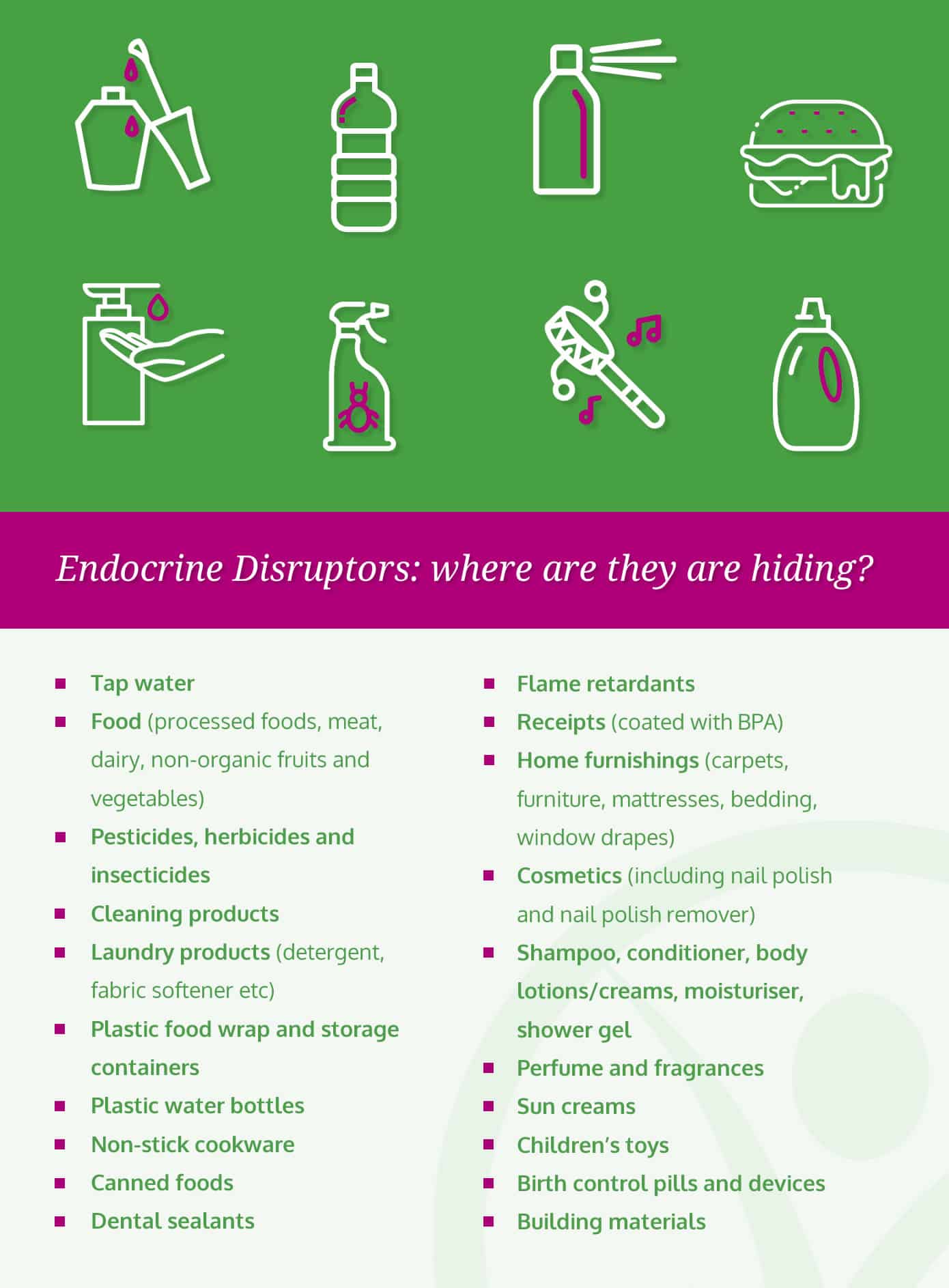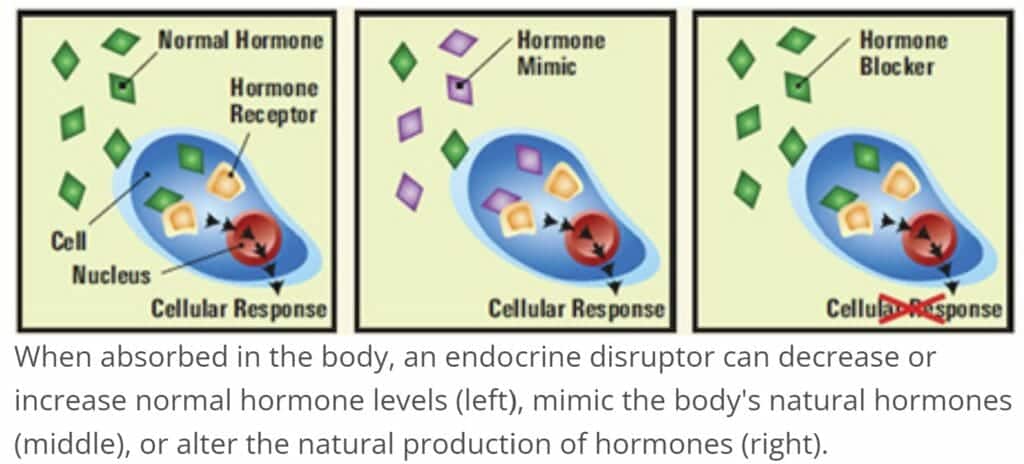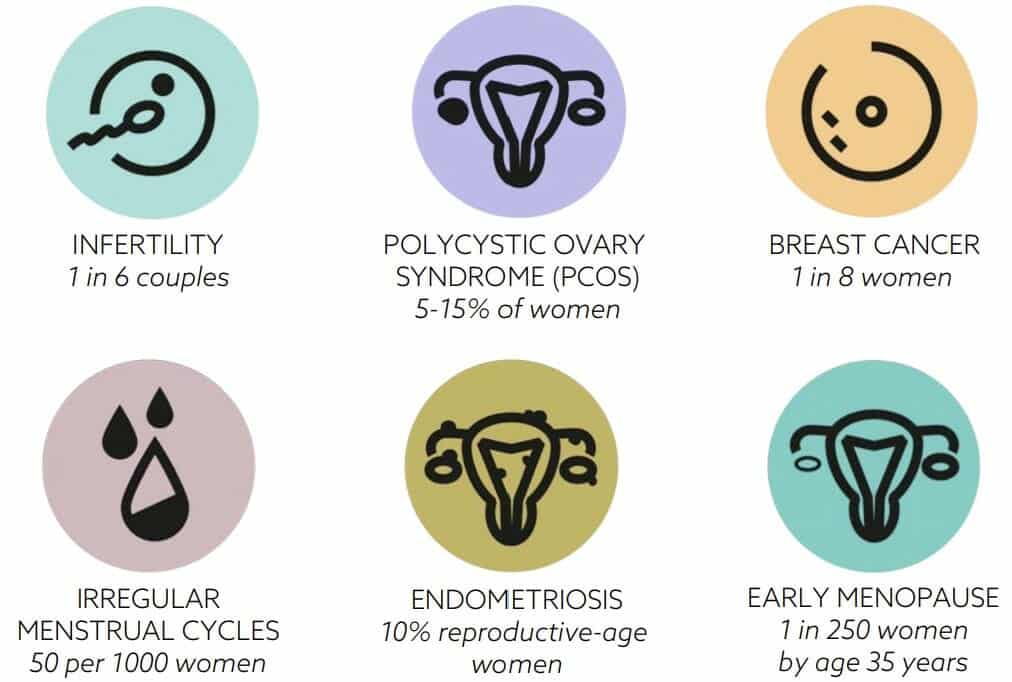When you look at all the causes of disease, many of them are “silent killers”.
They are invisible to the naked eye and you have no idea they’ve been affecting you for years on end.
In fact, they could be affecting you right now and charting you on the fast path towards poor health.
One of the most insidious groups of compounds deteriorating your quality of life is endocrine-disrupting chemicals.
They exist everywhere and you can’t avoid them in your day-to-day life (unless you want to live in the wilderness).
So instead of admitting defeat and giving up, I’m going to reveal what they are and how you can minimize their impact on your body.
Table of Contents
ToggleWhat Are Endocrine-Disrupting Chemicals (EDCs)?

Numerous health organizations have different definitions of what constitutes an EDC, so here are a few of them:
“A growing body of evidence, including reviews, clinical trials, and reports highlight new roles and effects of EDCs. EDCs are defined as ‘exogenous chemicals or mixture of chemicals that interfere with any aspect of hormone action’.
According to US Environmental Protection Agency (EPA), an EDC is an exogenous compound that may interfere with synthesis, secretion, transport, metabolism, receptor binding or elimination of endogenous hormones, altering the endocrine and homeostatic systems.
In the process of defining EDCs criteria proposed by European Commission, it seems clear that EDCs should exhibit three actions: (1) endocrine activity; (2) deleterious and/or pathologic endocrine mediated-activity; (3) cause-effect relationship between substance and endocrine activity in exposed subjects”
Yet EDCs share a set of devastating characteristics:
- They are not safe at (arguably) any dose, even extremely low concentrations
- They are most damaging when exposure happens during critical developmental periods (i.e. while in the fetus and during puberty)
- Unlike drugs, the drug-response relationship is not linear (i.e. a higher dose equals a higher response)
- EDCs interacting with each other can be additive, antagonistic, or synergistic (i.e. you’re dealing with exposure to multiple EDCs simultaneously)
- Long after exposure, their negative effects can be observed in both the individual and future generations
There are hundreds of EDCs out in the world and extensively covering all of them is far beyond the scope of this article.
Bisphenol A (BPA), Bisphenol S, Bisphenol F, Polychlorinated biphenyls (PCBs), Phthalates, Perchlorate, Atrazine… the list could go on forever and forever.
One major example of an EDC is soy protein, which I’ve talked about in The TOT Bible:
“Consuming soy protein and its variants are absolutely counterproductive to maximizing TOT.
Soy products are part of the many environmental, endocrine-disrupting toxins causing breast enlargement (gynecomastia), decreased facial and body hair growth, lowered libido, wild mood swings, higher body fat storage, erectile dysfunction and lowered sperm count.
It has also recently fostered a popular internet meme of “soy boys” to describe soft, weak and effeminate men who got that way from overeating soy and its various by-products.
…Unfortunately, most processed and refined foods are laced with soy by-products. The more of these foods you can remove from your diet, the healthier you’ll be.”
You would think this would be a global threat that receives non-stop attention in the press, but sadly it is not.
Why Are Endocrine-Disrupting Chemicals (EDCs) Not Talked About?

(Source)
Even though EDCs are just gaining widespread attention right now, the Environmental Protection Agency (EPA) notes that they have been a major health issue since as early as the 1970s (if not earlier):
“One example of the devastating consequences of the exposure of developing animals, including humans, to endocrine disruptors is the case of the potent drug diethylstilbestrol (DES), a synthetic estrogen. Prior to its ban in the early 1970’s, doctors mistakenly prescribed DES to as many as five million pregnant women to block spontaneous abortion and promote fetal growth. It was discovered after the children went through puberty that DES affected the development of the reproductive system and caused vaginal cancer.”
What makes EDCs especially more sinister is how difficult it is to isolate a single one, study it over the lifetime of an adult human being, and singlehandedly attribute one – or many – disease states to the presence of just one EDC:
“…studying the effects of these chemicals in humans is challenging for scientists. Much of experts’ current understanding is based on animal research or studies of trends in large populations.
“It’s very difficult to measure some of these chemicals in humans, and there aren’t biochemical tests for many of them… Plus, we’re exposed to many of these chemicals at once, so it’s hard to isolate their effects. It’s also likely that those effects develop over long periods of time.”
In other words, if you consider the infographic I just shared, being exposed to MULTIPLE EDCs makes it hard to pinpoint the culprit to just a single EDC.
Yet this hasn’t stopped scientists from making a very clear link between EDC exposure and worse health outcomes… the evolution of human biology is fast, but not as quick as you would believe:
“The incidences of these conditions have increased significantly not only in the United States but across the globe. Because genes do not change fast enough to explain this increase, environmental causes must be involved. The environmental contribution to disease is estimated to be 24–33% of the global disease burden.
“… identifying those chemicals with endocrine activity from all the chemicals used and released worldwide is a major challenge, and we are likely assessing only the “tip of the iceberg.” Hundreds of chemicals, as well as persistent organic pollutants, have been identified as EDCs. EDCs are not uniform: They have very different properties, sources, and fates in the environment. Although it may be possible to trace high production volume chemicals, numerous additives and process chemicals are not traceable”
Let’s add even more fuel to the fire — The regulations put in place by international health agencies to minimize EDC content in everyday consumer products are severely lagging with regards to when they come into effect:
“Over the last 70 years, more than 80,000 chemicals have been released into the environment through human activity. Because of inadequate health and safety laws, more than 85% of these chemicals have never been assessed for possible effects on human health.
Although many of them may not cause harm, a significant number of those that have been tested are now believed to increase our risk for serious health problems”
What was a fringe concept 25 years ago is now a worldwide phenomenon and it can no longer be ignored: They are a clear and present danger!
Again, as I wrote in The TOT Bible:
“…the modern environments we live in are catastrophic to our endocrine systems. Living in cities, working all day under fluorescent lights, and eating manufactured GMO foods is slowly but surely destroying our bodies.
The increase in environmental pollutants, contaminants, and particulates in the air produced by industrial factories, smog, emissions from cars, and more are bombarding our systems and lowering testosterone levels on a global scale .
Men are also under siege from hormone-suppressing phytoestrogens, by-products (such as soy protein ) and a host of other toxins that our bodies were not designed to handle, yet are commonplace today.”
Herbicides, pharmaceutical drugs, pesticides, cosmetics, plastics, sunscreens, plastics, man-made products such as hair dyes and shampoo and body wash… avoiding them is a losing strategy.
How Are Endocrine-Disrupting Chemicals Ruining Your Health?

Before I get into the numerous illnesses directly linked to EDC exposure, bear in mind it only takes a minimal amount of EDCs to put your health at risk:
“Even low doses of endocrine-disrupting chemicals may be unsafe. The body’s normal endocrine functioning involves very small changes in hormone levels, yet we know even these small changes can cause significant developmental and biological effects. This observation leads scientists to think that endocrine-disrupting chemical exposures, even at low amounts, can alter the body’s sensitive systems and lead to health problems.”

(Source)
To show you just a glimpse of what we believe is heavily linked with EDC exposure, I’ll refer you to a bombshell report presented to the House of Representatives in 2010 titled “ENDOCRINE-DISRUPTING CHEMICALS IN DRINKING WATER: RISKS TO HUMAN HEALTH AND THE ENVIRONMENT”.
In one part of the hearing, a study was discussed where an environmental working group analyzed infant umbilical cord blood samples and identified industrial compounds, pollutants, and complex mixtures of both in each infant.
These industrial chemicals cross the placenta in large numbers and contaminate babies in the womb (in utero).
Here’s what they concluded:
“We know that exposure to EDCs at very sensitive stages of development can result in profound changes in physiology and function that may not emerge clinically until much later in life.
The exposure itself may cease, but the developmental impact and the subsequent adverse effect have already been set in motion.”
Some of the shocking outcomes with respect to specific diseases include:
- A tripling of asthma rates over the past 30 years
- Over the past 20 years, testosterone levels have dropped dramatically
- An increase in primary brain cancer by almost 40%
- Widespread rates of childhood obesity and diabetes that show no signs of slowing down
- One of the leading causes of death among children is cancer
- A development disorder is present in one out of six American children
I wrote about the effects of EDC on testosterone production a few years back on Ben Greenfield’s website, which I’ll summarize here:
EDCs can not only decrease testosterone production but also interfere with its signal transduction (i.e. androgen receptor binding, transcription, and translation).”
“Bisphenol-A, Phthalates, Atrazine and other toxins are increasingly pervading our water and food supplies. Exposure to phthalates (found in rubber, packaging, plastics, water bottles, etc.) blocks normal testosterone production”
“EDC exposure is so bad, in fact, that a “Type 3” hypogonadism has emerged that can ultimately be classified as “Testosterone Resistance Syndrome” (TRS). (This Type 3 classification is the theory of Dr. Scott Howell, Dr. Keith Nichols and myself and currently, Dr Howell is working on proving this in the scientific community.)”
(For more information about TRS, listen to this podcast and watch this webinar I have done with Dr. Keith Nichols)
As you already know, lower testosterone levels slowly kill your quality of well-being:
“Exposure to chemicals found in plastics and personal care products called phthalates are “feminizing” males by blocking normal testosterone production…
When you are commonly exposed to these endocrine-disrupting chemicals, your testosterone levels will decline, and you’ll start to feel less energetic over time. It sneaks up on most men in the form of low energy and low vitality, who then accept this as a natural side effect of being “old.” When you suffer from low levels of testosterone, you can be classified as hypogonadal.”
Add on the possibility of impaired penile development and lowered fertility – among other things – and you have a recipe for multi-generational disaster.
But this goes far beyond men’s health as women are also negatively affected.
Just to start off on a light topic, a woman’s menstruation is impacted by EDCs:
“In 2017, a Korean media outlet decided to investigate the chemicals found in commercial menstrual pads, based on the advocacy and awareness-raising efforts of the Korean Women’s Environmental Network, who had pointed out that menstruating people seemed to be developing rashes, discomfort, and even infertility from the pads.
Although the quantities of volatile organic compounds were not too alarming—they weren’t too different than what we are already exposed to, and you can reduce them by letting these products air out a bit before using them—the phthalates were another story.
…The solution is not as simple as deciding on acceptable thresholds of chemicals or replacing ingredients. The key question is: How were these materials permitted in the first place?”
And just as with men, the effects can span one or even many generations:
“In Europe alone, the burden of diseases as a consequence of exposure to endocrine disrupting chemicals (EDCs) is estimated to cost at least 163 billion euros every year. This is around 325 euros for each European citizen, every year. Part of these costs is related to women’s reproductive health issues, such as uterine fibroids (163 million) and endometriosis (1.25 billion).
It is difficult to give a cost estimate for female infertility due to EDC exposure, because the reason for not becoming pregnant is often unexplained and may be caused by female factors, male factors or a combination of both. It is clear though, that the demand for assisted reproductive techniques (ART) such as in vitro fertilization (IVF) has risen over the last 40 years. The contribution of EDCs to the cost associated with ART is estimated at 4.7 billion euros.”

(Source)
Let me put this in very clear terms: If you were born in a first world industrialized area in the last 30 years, you are very likely hormonally compromised due to your endocrine system being ravaged by EDC’s in utero.
The majority of humans living in first-world Western societies will struggle to maintain natural optimization due to EDC exposure, both in utero and in their current day-to-day life.
Useful Tips For Minimizing Exposure To Endocrine-Disrupting Chemicals

Powerful factors in our modern-day environment are constantly placing our endocrine systems under siege.
This environmental assault overshadows most men’s natural ability to produce testosterone, and their efforts to fix low testosterone levels.
So what are your options?
Ultimately the best option will be to minimize your exposure to EDCs as much as possible, as outright prevention is impossible.
I can’t possibly provide every single tip in existence because there’s simply far too many things you can do.
However, I can give you some major tips you can start implementing today:
- Go for cosmetic and hygiene products that are free of fragrances, sulfates, phthalates (i.e. avoid fabric softeners and air fresheners)
- Get rid of plastics used for storing food and drink (this includes water bottles) and especially DO NOT heat plastic containers in a microwave or put them in your dishwasher. Instead opt for glass products
- Live a fully optimized lifestyle — eat organic, drink plenty of water, exercise daily, limit sugar, avoid alcohol and drugs, use saunas, and perform a monthly detox
- Make sure your vegetables, fruit and meat comes from whole sources (fresh or frozen) instead of being canned. If you can, buy them organic and make sure you wash them thoroughly before eating them.
- Receive proof of all your transactions digitally, as printed receipts use thermal paper that are coated with BPA.
- Switch your cookware to something made of cast iron, stainless/carbon steel, or glass — avoid the use of non-stick cookware
- Ensure your house is cleaned on a frequent basis to prevent dust and other EDCs from building up in your home
- Make sure your water is filtered before you drink it to avoid ingesting xenoestrogens and phthalates, and drink it out of a glass (I personally prefer deuterium-depleted water)
There are many more advanced strategies at your disposal but this will be a good starting point and will stop EDCs from having a major effect on your future health.
Diving Deeper Into The Rabbit Hole Of Endocrine-Disrupting Chemicals

EDCs continue to cause widespread dysfunction and disruption of the male and female hormonal systems due to their overwhelming presence in dangerous quantities within everyday items.
And combatting this starts with the creation of a society that must be hormonally optimized to fight through the modern-day environment.
So here are some additional resources to keep you more knowledgeable and well-protected against the subtle yet deadly effects of EDCs…
Dr. Anthony Jay’s book Estrogeneration is probably the most comprehensive resource ever written on where EDCs come from and how to remove them from your life as much as possible.
Dr. Axe and Precision Nutrition have some long-form articles written on the most important EDCs to watch out for and specific strategies for avoiding each one.
Several scientific papers (here, here, and here) and this 3-part review detail the more complicated mechanisms through which EDCs manifest unwanted health outcomes.
Finally, this short YouTube video documents how EDCs may potentially damage the heart and the brain.
When you’re ready to accelerate your journey towards supreme health, make sure you join The Fully Optimized Health Private Membership Group
It’s your greatest opportunity to fully optimize your health, gain total access to myself and Daniel kelly, and network with high-level men looking to 10X their life.
You’ll also get access to our best-selling books and webinars for free, state-of-the-art testosterone optimization, cutting-edge research on peptides and supplements, interviews with spiritual masters, and our “black book” rolodex of the world’s best hormonal health physicians.
And As always…




